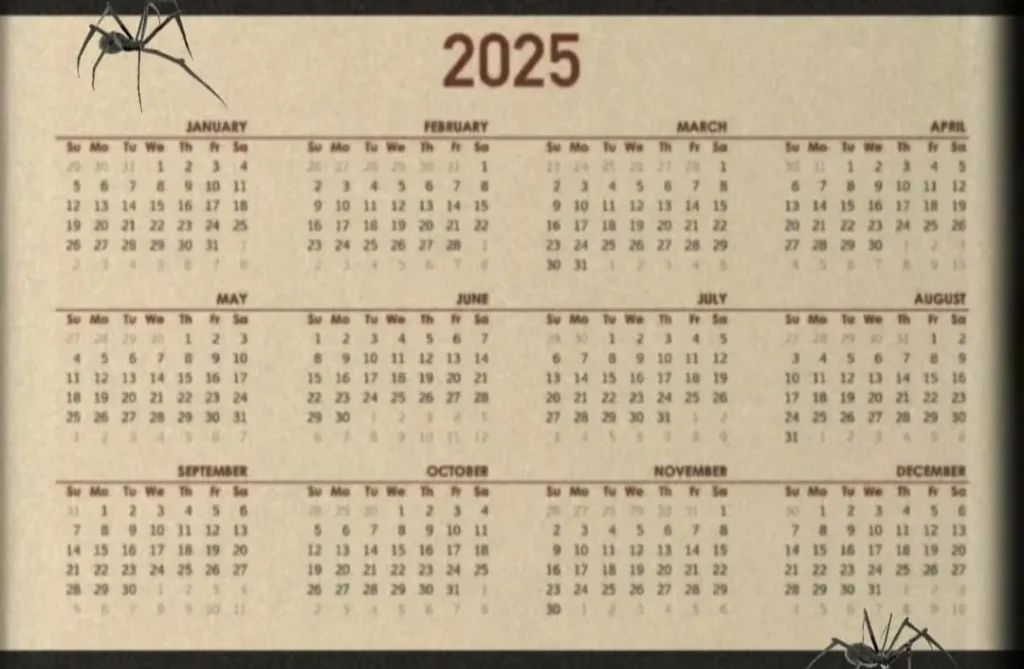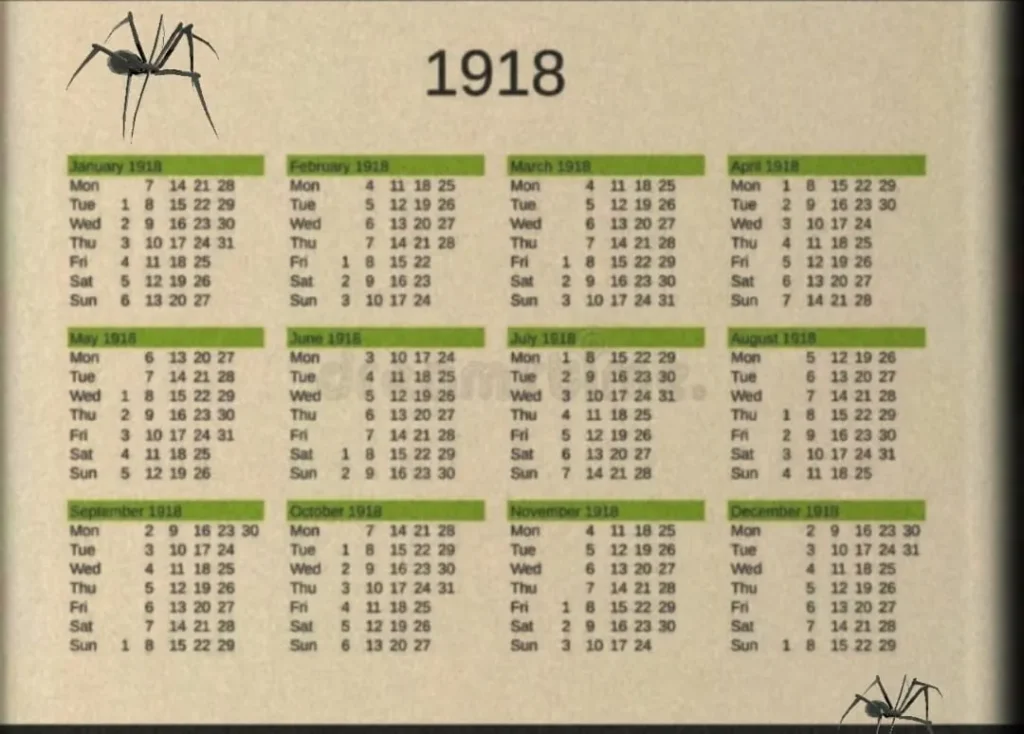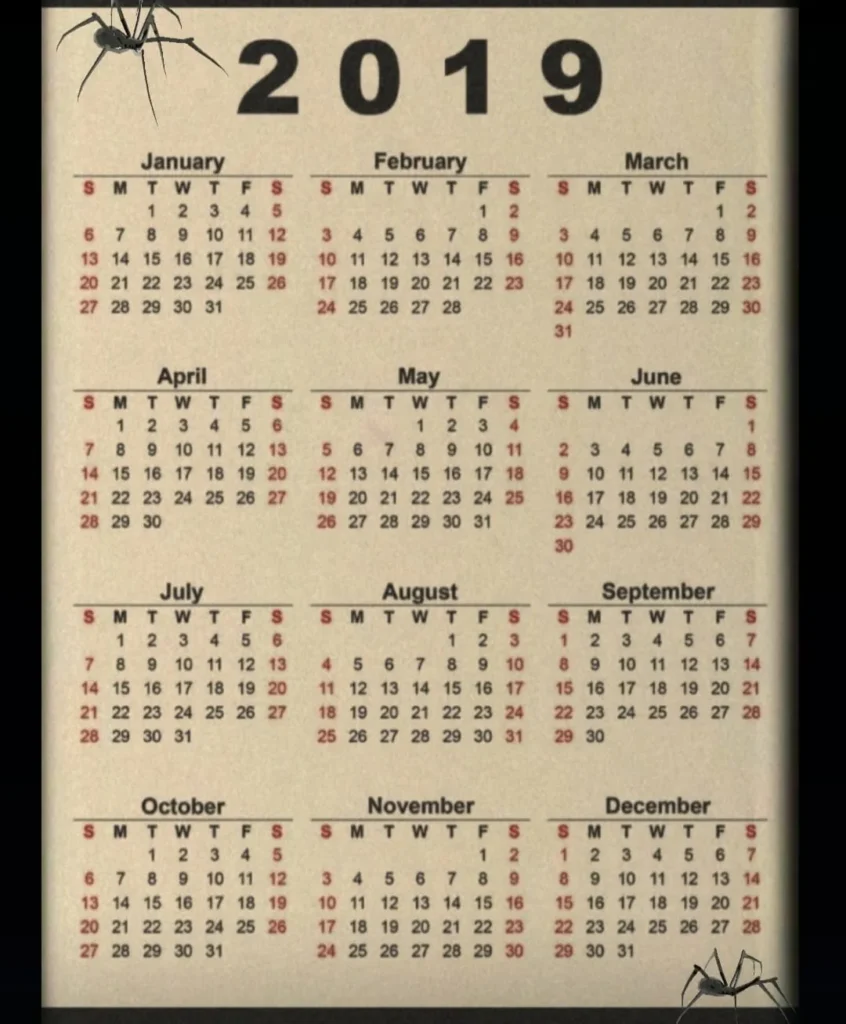Are we living in a time loop? Was everything’s already written? These questions made the philosophers stunned. The curse of repeating years made the whole world silent. Is this just a coincidence or maybe some sign. Do we have to get more prepared for the upcoming dangers. In this blog, you’ll learn about the calendars of 1941, 2025, 1918, and 2019. These years are not only synchronized by the same dates and days, but also share remarkable histories.
Calendar : 1941 & 2025
Year 1941

As you can see, 1941 and 2025 calendar are synced perfectly. Also, let me tell you the history of 1941.
World War II took place during this year and also there were :
- Mass killing of civilians
- Bombings
- Starfish
- Genocides
1941 was a year of war, destructions and death.
Year 2025

2025 year also holds serious curses like :
- California fire
- Mahakumbh Stampede
- Pahalgam Attack
- RCB Stampede
- Ahemdabad Plane Crash
- Iran and Israel War
- Train Derailment
And more to go….
Tragedies of 1941
1. The Nazi invasion of the Soviet Union (Operation Barbarossa)
It was on 22nd of June 1941, Adolf Hitler launched a deadliest operation named – Barbarossa. It was one of the largest military invasion in history. This attack led to:
- Mass killings of soldiers and civilians.
- The destruction of entire towns and villages.
- Millions of Soviet soldiers were either killed or captured.
- The beginning of the Holocaust in Eastern Europe — where Nazi forces started the mass murder of Jews on a horrifying scale.
The Eastern Front became the deadliest battlefield of World War II.
2. The Pearl Harbor Attack
It was on 7th of December 1941 when Japan launched a surprise military strike on the American naval base at Pearl Harbor, Hawaii. This attack led to :
- The death of 2400 Americans.
- The destruction of many U.S. battleships and aircraft.
- Enter World War II the very next day (December 8, 1941).
This attack widened the war throughout the Pacific, turning it into a truly global conflict.
3. The sinking of ships and naval tragedies
During 1941, people saw the sinking of many ships. Those ships were :
- The HMS Hood (May 24, 1941): This ship was pride of the British Navy. It was destroyed by the German battleship Bismarck. Over 1,400 sailors died and only 3 sailors survived by luck.
- The Bismarck was a ship that sunk a few days later after The HMS Hood with over 2000 German sailors.
The Atlantic Ocean became a graveyard for countless sailors.
4. The Blitz continues in Britain
The German bombing campaign called The Blitz began in 1940 and continued to 1941. Cities like London, Coventry, and Belfast were heavily bombed. The were a huge destructions like :
- Thousands of civilians were killed.
- Families were left homeless.
- Entire neighborhoods were turned into rubble.
5. The Holocaust escalatesDurin
During 1941, in the Eastern Europe, Nazi Germany began mass executions of Jews and other minorities. There were mobile killing squads called Einsatzgruppen, they followed the German army and murdered:
- Jews
- Roma (Gypsies)
- Political opponents
- Disabled people
6. The Battle of Hong Kong and other Asian tragedies
In December 1941, Japan attacked Hong Kong and other parts of Asia. Many innocent people lost their lives, and those who were captured faced terrible suffering. This attack made the war even bigger and brought pain and hardship to millions of people across Asia.
Tragedies of 2025
1. Earthquake in Japan (February 2025)
In February 2025, a powerful earthquake struck off the coast of Japan near the Tōhoku region, registering over 8.0 on the Richter scale. The quake triggered a massive tsunami that tore through coastal towns, leaving a trail of destruction. Thousands of homes were swept away, and countless people lost their lives or went missing. Rescue teams struggled to reach survivors as aftershocks and damaged roads, bridges, and infrastructure hampered relief efforts.
2. Deadly Floods in Brazil (March-April 2025)
Heavy rainfall battered southern Brazil in early 2025, triggering devastating floods and landslides across Rio Grande do Sul. Entire communities vanished beneath rising waters, bridges crumbled, and more than a hundred lives were lost. Thousands of families were forced to flee their homes, carrying what little they could. Rescue workers fought day and night to reach survivors, but many areas remained isolated for days, cut off by the destruction.
3. Heatwave in Europe (June 2025)
A blistering heatwave gripped Europe, breaking records as temperatures soared past 45°C (113°F) in parts of Spain, Italy, and Greece. The unbearable heat sparked wildfires, left homes without power, and tragically claimed hundreds of lives. In some areas, fields dried up and crops withered, deepening the struggles faced by communities.
4. Plane Crash in Africa (May 2025)
Tragedy struck in West Africa when a commercial passenger plane crashed shortly after takeoff, reportedly in Mali. Heartbreakingly, there were no survivors — everyone on board, both passengers and crew, lost their lives. Early investigations point to a possible technical failure, but authorities are still working to uncover the full story.
5. Conflict and Civilian Suffering (Ongoing)
In 2025, the violence in places like Sudan, Ukraine, Gaza, and Myanmar continued to bring heartbreak and loss. Innocent people — including women and children — were caught in the crossfire, enduring relentless bombings, being forced from their homes, and struggling to survive without enough food, clean water, or medical care.
6. Deadly Fire in Dhaka, Bangladesh (January 2025)
A devastating fire tore through a residential building in Dhaka, claiming the lives of dozens. As flames spread with terrifying speed, fueled by unsafe construction and the absence of proper fire exits, many residents found themselves trapped inside, with no way out. Helpless cries echoed through the night as families were engulfed by the disaster.
7. Ebola Resurgence in Africa (early 2025)
A new outbreak of Ebola struck parts of Central Africa, spreading fear and heartbreak as it claimed lives before help could arrive. Families watched helplessly as their loved ones fell ill, while communities grappled with uncertainty and grief. It was only after international medical teams reached the affected areas that the spread of the deadly virus began to slow.
Calendar : 1918 & 2019
Year 1918

The year 1918 and 2019 calendar are also synced with each other. Their histories had also been repeated.
As you dig deeper into the books of history, during 1918 there was a deadliest flu which was spread across cities to cities and killed millions of people. The name of that flu was – “Spanish Flu”.
Year 2019

Overall, you know that on 2019, Corana Virus spread like air and people all around the globe died because of this deadliest virus.
Tragedies of 1918
1. The Spanish Flu Pandemic
One of the most heartbreaking tragedies of 1918 was the Spanish Flu — a deadly influenza pandemic that swept across the globe, leaving devastation in its wake. It began early that year and raged on into 1919, spreading like wildfire as World War I drew to a close and soldiers carried the virus from country to country.
The Spanish Flu infected around 500 million people — almost a third of the world’s population at the time. It claimed at least 50 million lives, and some believe the true toll could have been as high as 100 million.
What made this flu especially terrifying was that it didn’t spare the strong. Unlike most flu outbreaks, it struck down healthy young adults in huge numbers, not just the elderly or very young. Families watched in helpless horror as loved ones, full of life just days earlier, fell ill and died with shocking speed.
Doctors and nurses fought bravely, but medical science simply wasn’t ready for such a catastrophe. Hospitals overflowed, and there weren’t enough hands to care for the sick. Fear gripped entire communities. In many places, whole families vanished. Cities tried to slow the spread — people were ordered to wear masks, schools and theatres shut their doors, and funerals were hastily arranged because there were just too many bodies to bury.
2. World War I and Its Final Battles
1918 marked the final, agonizing year of World War I — a brutal conflict that had raged across Europe since 1914, leaving devastation and heartbreak everywhere it touched.
By the time the guns finally fell silent, millions of soldiers had been killed or maimed. The year saw some of the war’s bloodiest and most desperate fighting: Germany’s massive Spring Offensive tried to break the stalemate, while the Allied Hundred Days Offensive slowly forced the German army into retreat.
For those trapped on the front lines, life was a nightmare. Soldiers endured the horrors of trench warfare, choking on poison gases like mustard gas, and living under constant threat of shelling. The mud, the fear, the endless death — it felt like the war would never end.
Civilians weren’t spared the misery. Cities and towns were bombed, farmlands destroyed, and hunger became a cruel companion for many. Families waited in dread for news from the front, hoping their loved ones might return.
At last, on November 11, 1918, the fighting stopped. The armistice brought an end to the slaughter, but Europe lay shattered — scarred by four years of unimaginable loss and destruction.
3. Famine and Hardship
The war and the flu brought terrible hardship, leaving many people without enough to eat. In countries like Germany, Austria-Hungary, and across parts of Eastern Europe, blockades cut off vital food supplies, and countless civilians faced hunger and starvation. Even in the nations that emerged victorious, ordinary families struggled with poverty and went to bed hungry, trying to survive in the shadow of so much devastation.
4. Political Collapse and Revolutions
The chaos of war and the spread of deadly disease in 1918 shattered old powers and changed the world forever. The German Empire, the Austro-Hungarian Empire, and the Ottoman Empire all crumbled under the weight of defeat and unrest. In Germany, the Kaiser abandoned his throne and fled, as angry crowds filled the streets and a new government rose from the turmoil. In Russia, the civil war raged on, with the Red (Bolshevik) and White forces locked in a brutal struggle that brought more bloodshed and suffering to a country already in pain.
Tragedies of 2019
1. Christchurch Mosque Shootings (New Zealand)
On 15 March 2019, tragedy struck the peaceful city of Christchurch. During Friday prayers, a gunman stormed two mosques, opening fire on worshippers who had gathered in faith and peace. In just moments, 51 innocent lives were cruelly taken, and many more were left wounded — their families forever changed. The horrifying attack sent shockwaves across the world, uniting people in grief and sparking urgent calls for change. In the aftermath, New Zealand came together in sorrow and solidarity, leading to major reforms in the country’s gun laws to help prevent such heartbreak from happening again.
2. Sri Lanka Easter Bombings
On 21 April 2019, Easter Sunday — a day meant for hope and celebration — turned into a nightmare for the people of Sri Lanka. Suicide bombers carried out brutal attacks on churches filled with worshippers and hotels bustling with guests, shattering lives in an instant. The coordinated blasts claimed the lives of over 250 innocent people, including families gathered in prayer and travelers far from home. The air was filled with sorrow and disbelief as communities mourned their loved ones, and the world stood in solidarity with Sri Lanka in the face of such unimaginable heartbreak.
3. Amazon Rainforest Fires
Throughout 2019, the Amazon rainforest — often called the “lungs of the Earth” — was engulfed in flames. Massive wildfires raged for months, turning millions of acres of vibrant, life-giving forest into ash and smoke. The fires devastated Indigenous communities who had lived in harmony with the land for generations, drove countless animals from their habitats, and sent thick plumes of smoke across the skies. People around the world watched in anguish as this vital part of our planet, so crucial for the air we breathe and the fight against climate change, burned before our eyes. The disaster sparked an outcry for urgent action to protect the Amazon and all who depend on it.
4. COVID-19 Outbreak Begins (China)
In December 2019, in the bustling city of Wuhan, China, the first cases of a strange, unexplained pneumonia began to surface. At first, few could have imagined the danger this new illness posed. The virus — later named COVID-19 — started spreading quietly, moving from person to person as the world went about its usual routines. No one knew that life was about to change in ways we’d never seen before. What began as a handful of infections would soon become a global pandemic, touching every corner of the planet and leaving a lasting mark on families, communities, and the way we live.
Final Thoughts
As we look back on the years 1918, 1941, 2019, and 2025, it’s impossible not to feel a sense of déjà vu. The same struggles — war, disaster, disease, and heartbreak — seem to return, as if history keeps finding ways to repeat itself. And when we notice how the calendars of these years line up so perfectly, it’s hard not to wonder: is this just coincidence, or is there something deeper at play?
But maybe these patterns aren’t some curse or proof that we’re trapped in a time loop. Maybe they’re reminders. Reminders that we, as human beings, need to learn from what came before. That we have to stay alert, act with kindness, and be ready for whatever challenges come next. Every tragedy leaves behind pain and loss — but also stories of courage, togetherness, and hope.
In the end, it doesn’t matter whether history is already written or shaped by the choices we make along the way. What matters is that the future is ours to create. Let’s take the lessons of the past and use them to break these cycles of suffering — and write new chapters filled with peace, progress, and compassion.
